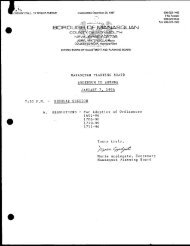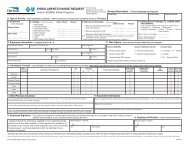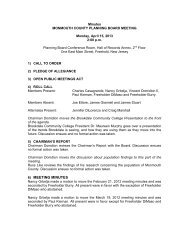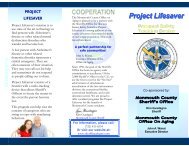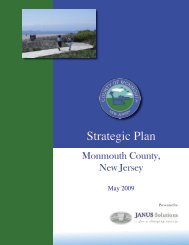NATURAL and CULTURAL FEATURES of MONMOUTH COUNTY
NATURAL and CULTURAL FEATURES of MONMOUTH COUNTY
NATURAL and CULTURAL FEATURES of MONMOUTH COUNTY
You also want an ePaper? Increase the reach of your titles
YUMPU automatically turns print PDFs into web optimized ePapers that Google loves.
2-3 million years, the Wisconsin, began melting about 21,000 years ago. The resulting<br />
sedimentation from the glacial melt built out a broad sloping plain <strong>and</strong> a continental shelf for<br />
about 185 miles from the present shoreline (NOAAPB, 2009). About 2500 years ago, sediment<br />
along the shore began accumulating <strong>and</strong> barrier isl<strong>and</strong>s, dunes, bays <strong>and</strong> other aspects <strong>of</strong> the<br />
present-day shoreline began to develop (Roberts <strong>and</strong> Youmans, 1993). Barriers are the dominant<br />
shoreline type along the Atlantic coast, but only comprise 15% <strong>of</strong> shorelines globally (EPA,<br />
2009). The shaping <strong>of</strong> the Atlantic coast is due to its sloping l<strong>and</strong>scape, the slow rates <strong>of</strong> sea<br />
level rise for the past 5000 years, the sufficient s<strong>and</strong> supply, <strong>and</strong> relatively minor tectonic<br />
activity (the cliffs that characterize the Pacific coast are due to the more recent collision <strong>of</strong><br />
tectonic plates) (EPA, 2009). About 500 years ago the accumulation <strong>of</strong> sediment along the<br />
Atlantic coast reversed, <strong>and</strong> s<strong>and</strong> began to be eroded <strong>of</strong>fshore (Roberts <strong>and</strong> Youmans, 1993).<br />
If massive amounts <strong>of</strong> glacial meltwater reduce the salinity <strong>of</strong> the ocean in the North Atlantic, it<br />
could prevent the northward flowing Gulf Stream from sinking near Greenl<strong>and</strong> <strong>and</strong> flowing<br />
south along the ocean floor towards Antarctica, shutting down the global network <strong>of</strong> currents that<br />
sustains climate (WU, 2009). Studies <strong>of</strong> ocean sediments in the North Atlantic <strong>and</strong> <strong>of</strong> ice cores<br />
in Greenl<strong>and</strong> reveal that the Great Ocean Conveyor Belt (also know as thermohaline circulation<br />
<strong>and</strong> the Meridional Overturning Circulation) has shut down many times in the past, <strong>of</strong>ten<br />
coinciding with abrupt climate change (WU, 2009). According to a 2005 report by Princeton<br />
University, sea level rising slowed 6000 years ago; a global-mean sea level rise <strong>of</strong> .1 to .2<br />
mm/year has been happening in the last 3000 years, <strong>and</strong> this rate may have doubled since the mid<br />
nineteenth century. Their model predicts that sea levels will rise 2-4 feet by the end <strong>of</strong> the 21 st<br />
Century, moving the shoreline back 240-480 feet, which will inundate 1-3% <strong>of</strong> NJ’s l<strong>and</strong> areas,<br />
<strong>and</strong> periodically flood 6.5-9%. It may increase flooding 3-20 times in the coastal areas located<br />
in the current 100-year flood level <strong>of</strong> 9.5 ft (2.9 m), <strong>and</strong> predicts that 100-year floods will occur<br />
every 5 years (Cooper et. al., 2005). For every degree that the ocean warms, sea level rises<br />
about a foot; a three foot rise would jeopardize all bayside property with flooding (Farrell, 2007).<br />
NJ is especially vulnerable to rising sea level due to geologic subsidence (the coastline is sinking<br />
under the weight <strong>of</strong> accumulating <strong>and</strong> compacting sediment, due in part to freshwater withdrawal<br />
from coastal aquifers), the topography <strong>of</strong> its coastline, current coastal erosion, <strong>and</strong> a high density<br />
<strong>of</strong> coastal development (EPA, 2009; SNJ, 2008). If the Greenl<strong>and</strong> ice sheet continues to melt at<br />
the rates currently being measured, global sea level rise will increase significantly, <strong>and</strong> the<br />
severity <strong>and</strong> frequency <strong>of</strong> coastal flooding in New Jersey will be even greater (SNJ, 2008).<br />
Fourteen <strong>of</strong> the twenty largest urban centers in the US are located within 100 km (62 miles) <strong>of</strong><br />
the coast with elevations less than 10 m (32.8 ft) above sea level (the 10 m elevation is the<br />
common benchmark to study flooding) (EPA, 2009).<br />
Between 1780 <strong>and</strong> 1980, thirty nine percent <strong>of</strong> NJ’s original 6000 km2 <strong>of</strong> coastal <strong>and</strong> interior<br />
wetl<strong>and</strong>s, which buffer storm surges along the coast, were lost to human activities; about one<br />
fifth <strong>of</strong> this happened between 1950 <strong>and</strong> 1970. The annual rate <strong>of</strong> loss slowed to 7 km2 between<br />
1986 <strong>and</strong> 1995 (Cooper et. al., 2005). The additional stormwater volume from impervious<br />
surfaces like asphalt – which produce as much as 16 times more water than undeveloped woods -<br />
increases the probability that two-year, channel forming (bankfull) storms will swell streams<br />
from once every 2 years, to 5 times every 2 years (Snodgrass, 1998). Bankfull storms are used<br />
as design storms for constructing stormwater infrastructure <strong>and</strong> Best Management Practices such<br />
as detention basins; it is predicted that by the end <strong>of</strong> this century, as Atlantic City floods, storms<br />
that are now happening once every hundred years will be occurring once every 1-2 years<br />
(UCSUSA, 2008). The present 100-year storm produces a rise <strong>of</strong> 2.89 meters above National<br />
Geodetic Vertical Datum (NGVD) for the Atlantic coast <strong>of</strong> New Jersey (Lathrop et al., 2007).




